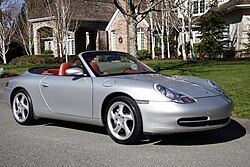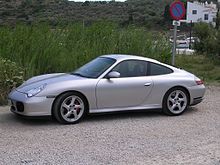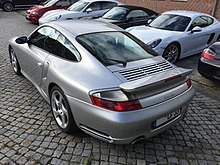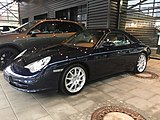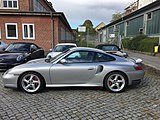Porsche 996
| Porsche | |
|---|---|
| 996 | |
| Sales designation: | Porsche 911 |
| Production period: | 1997-2006 |
| Class : | Sports car |
| Body versions : | Coupé , convertible |
| Engines: |
Petrol engines : 3.4-3.6 liters (221-355 kW) |
| Length: | 4435 mm |
| Width: | 1770-1830 mm |
| Height: | 1295 mm |
| Wheelbase : | 2350 mm |
| Empty weight : | 1380-1560 kg |
| Previous model | Porsche 993 |
| successor | Porsche 997 |
The Porsche 996 is a 2 + 2-seater sports car from Porsche AG, which was manufactured in Zuffenhausen from 1997 to 2006 . The vehicle is the successor to the Porsche 993 and the fifth generation of the 911 series .
The 996 is the first model of the 911 series with a water-cooled engine and (after the Porsche Boxster introduced in 1996 ) the second Porsche model with a boxer engine without air cooling . In 1997, Porsche finally gave up this concept that had been in use for fifty years.
The Porsche 996 was designed by Harm Lagaay . The body shape and interior differ considerably from the previous model.
Model creation
The Porsche 996 replaced the Porsche 993 from the 1998 model year (W program). With it, a new era began in the 911 series. All 911s produced up to then had an air-cooled six-cylinder boxer engine; since 996 they have had a six-cylinder boxer engine with water cooling. This became necessary in order to meet the consumption and exhaust gas regulations together with the internally set requirements for engine performance. Above all, the four-valve technology with two overhead camshafts ( DOHC ) could not be implemented with air cooling.
Unlike the previous models, the 996 body is no longer based on the original design by FA Porsche from 1963. The body was 19 cm longer and 9.5 cm wider, and the handling was more comfortable. The 996 series is the best-selling 911 series.
As with the previous model 993, there are three body styles of the 996: Coupé (closed), Targa (semi-open) and Cabriolet (open). Coupé and Cabriolet were optionally available as Carrera or Turbo models. The 996 Targa was only produced as a Carrera .
The output of the six-cylinder boxer engines ranges from 221 kW (300 PS) to 254 kW (345 PS) in the naturally aspirated versions and from 309 kW (420 PS) to 355 kW (483 PS) in the turbocharged versions.
The vehicle is available with a six-speed manual transmission or with an automatic transmission called Tiptronic . When Carrera is available as an alternative to rear-wheel drive with the models Carrera 4 and Carrera 4S all-wheel drive . The turbo has all-wheel drive as standard.
body
With the new design of the 996, Porsche moved away from the classic 911 shape. On the one hand, the car was longer and wider than its predecessor, so that it is more reminiscent of a comfortable Gran Turismo than a spartan sports car. Eye-catching are the headlights integrated flat in the fenders on this model, which are often referred to as fried egg lights because of their appearance . For reasons of cost, the headlight was developed as a component with five functions (low beam, high beam, indicator, parking light and fog light) for the 996. Many components of the Porsche 996 (headlights, fenders, etc.) were also used in the Porsche Boxster . This and above all the “risk of confusion” with the Boxster earned the new 996 a lot of criticism. From 2002 the headlights were replaced by differently designed clear-glass headlights and made the 996 appear more independent compared to the Boxster.
The loss of the continuous light strip at the rear was also lamented, which was therefore reintroduced as a type feature, at least for the 4S model. This model has the widened body, front and rear aprons and side skirts of the 996 Turbo as well as a slightly lowered body and an enlarged braking system. In contrast to the Turbo, Porsche did without its fixed rear wing and the air inlets in the rear fenders in the Carrera 4S. Fuel consumption has also been reduced thanks to the lower drag coefficient of 0.30 (993: 0.34). Furthermore, the 996 is easier to handle thanks to the smaller turning circle (also with all-wheel drive) of 10.6 m (993: 11.74 m).
The exterior of the 996 GT3 differs from the “ordinary” 996. It has a separate front apron, modified side skirts, a fixed rear wing and model-specific 18-inch alloy wheels.
The 996 Targa has a glass roof system, the middle section of which can be moved electrically under the rear window and, if necessary, can be darkened with a roller blind - basically like an oversized sliding glass roof. The line of the rear side windows is also slightly different from the other 996 variants.
The body was kept straighter, especially on the fenders and doors. The typical transition from the front fender via the entrance doors to the rear fender is missing on the Porsche 996.
The appearance of the Porsche 996 underlined the new vehicle concept.
Exterior paintwork
In addition to uni paints, there were a number of different metallic finishes.
University:
| black (since 1997) |
Guards Red (since 1997) |
glacier white (1997 to 1998) |
pastel yellow (1997 to 1999) |
Carrara white (2000 to 2004) |
speed yellow (1997 to 2006) |
Metallic:
| black (1997 to 2002) |
ocean blue (1997 to 2000) |
arctic silver (1997 to 2006) |
arenarot (1997 to 2000) |
zenith blue (1997 to 2000) |
vesuvio (1997 to 2000) |
fir green (1997 to 1998) |
| basalt black (2002 to 2006) |
night blue (1997 to 2006) |
slate (2002 to 2006) |
atlas gray (2002 to 2006) |
polar silver (1997 to 2004) |
palladio (1997 to 2000) |
lago green (2002 to 2003) |
Metallic pearl effect:
| lapis blue (2001 to 2006) |
seal gray (2001 to 2006) |
orient red (2000 to 2002) |
orange red (2000 to 2002) |
jungle green (2000 to 2002) |
Metallic special color:
| GT-silver (only 2004) |
violet chrome flair (only 2000) |
The 911 special model "40 Years of 911" was only available in GT silver metallic.
The special model "Millennium Edition" could only be purchased in the color violet chrome flair metallic.
engine

The six-cylinder boxer engines are similar to those of the Boxster series and only have the number of cylinders in common with the air-cooled engines of the previous 911 models. The previously used dry sump lubrication with an external oil tank became an "integrated" dry sump lubrication with an oil reservoir in the engine (Turbo, GT2 and GT3: external oil tank) and a pressure pump as well as three return pumps (bilge pumps): one per cylinder head plus one in the dry sump. Turbo and GT2 have seven return pumps: two for each cylinder head, one for each turbocharger and one in the dry sump. The separate oil cooler in the bow, which was still used in the previous model, the Porsche 993 , was omitted in favor of an oil / coolant heat exchanger on the engine. The heat is dissipated via the two coolers mounted on the side in the front. Vehicles with Tiptronic S have an ATF / coolant heat exchanger on the gearbox and an additional third front cooler in the middle of the car, which is also available on the 996 Turbo and GT2 (from model year 2001 = 1 program).
In place of the double ignition used in the previous model 993 , the 996 was given a " dormant ignition system " with six ignition modules.
The engine block is much more complex than the air-cooled engines, which consist of two halves with two timing chains. The new engines consist of four parts; the four camshafts are driven by a total of five chains: A duplex roller chain drives an intermediate shaft located under the crankshaft. From this intermediate shaft, a duplex roller chain each leads to the front and rear of the engine to the exhaust camshafts. These drive the associated inlet camshaft via a simplex roller chain, which works with a camshaft adjustment ( Vario Cam ). From model year 2002 (3.6 liter engine) with valve lift control ( VarioCam Plus ). In the Turbo, GT2 and GT3 models, a duplex roller chain each drives the inlet and outlet camshafts directly from the intermediate shaft.
At the time of its market launch, the Porsche 996 had an engine with a displacement of 3387 cm³ (3.4 liters), which generates an output of 221 kW (300 hp) at a speed of 6800 rpm. The engine thus achieved the performance of the 911 Turbo models of 1978 without a turbocharger . From the 2002 model year, the displacement was increased to 3596 cm³ (3.6 liters), which led to an increase in output to 235 kW (320 hp) at the same speed. The fuel consumption was around 11.1 liters of premium gasoline per 100 km.
The turbo version of the 996 with 309 kW (420 hp) at 6000 rpm was first produced in the 2001 model year. The engine with two intercoolers and two turbochargers (bi-turbo) has a displacement of 3600 cm³ (3.6 liters) and, unlike the engines of the Carrera models, is equipped with an external oil tank for dry sump lubrication . The engine also has the VarioCam Plus intake camshaft adjustment with valve lift control. The Tiptronic S was available as an option with five gears.
From the end of 2001, a so-called factory performance upgrade (order code X50) with 331 kW (450 hp) at 5,700 rpm and 620 Nm at 3,500–4,500 rpm was also offered for the 996 Turbo - just like the 993 Turbo - at an additional cost.
The increase in performance of the 331 kW engine was achieved through larger turbochargers (K24 instead of K16), more powerful intercoolers, higher maximum boost pressure (0.9 bar instead of 0.8 bar), different catalytic converters and exhaust mufflers . At the same time, the engine electronics were adapted and the transmission was reinforced with roller bearings. From autumn 2004 there was the 911 (996) Turbo S model with the same output of 331 kW.
In general, the engines of the 911 Turbo , 911 GT2 and 911 GT3 have been further developed from the six-cylinder boxer engine of the Porsche 911 GT1 . This vehicle itself looks similar to the 996, but was developed independently and according to a different vehicle concept; the engine is not installed in the rear as in the Porsche 996, but in front of the rear axle ( mid-engine ).
inner space

The interior, like the body, has been completely redesigned. Most noticeable are the changes in the instruments: the centrally located tachometer still dominates the dashboard as the largest instrument; the other four instruments have been repositioned and have a semicircular design similar to the Boxster. To the left of the rev counter are the speedometer and voltmeter and to the right the coolant temperature, tank and oil display. The imprecise readability of the speedometer in particular was often criticized. The speed is therefore also displayed digitally in the rev counter.
The center console and the interior door panels were also redesigned. All parts of the interior have been adapted to each other. This made the car appear harmonious on the inside, especially if it included extras that are subject to a surcharge, such as interior fittings in a leather, aluminum or carbon look. The seats of this model, however, have hardly changed compared to those of the predecessor.
The many revisions to the technical equipment made the 996 more practical and comfortable. As with the 993, many components were standard. New optional additional equipment, such as an electronic stability program , called Porsche Stability Management (PSM) at Porsche , or a built-in navigation device with Porsche Communication Management (PCM) and automatic air conditioning rounded off the offer.
For the first time, a CD navigation system with road map display, which can be ordered ex works, was offered from the 996 and 986 model series. The first variant (PCM 1, with 5-inch 4: 3 screen) came from the collaboration between Siemens (control, graphic user interface , navigation computer) and Harman Becker Automotive Systems (radio receiver, cassette deck, amplifier and CD changer control). After Siemens stopped manufacturing car navigation systems in 2003, Harman Becker later became the supplier of the entire PCM system. From September 2002 the new generation PCM 2 with 16: 9 screen was delivered.
In addition to the comfortable sports cars, Porsche also offered sports cars designed for racing, such as the 911 GT3 or 911 GT2 . These vehicles were lighter than the production models and had more powerful engines that developed 265 kW (360 hp) to 280 kW (381 hp) for the GT3 and from 340 kW (462 hp) to 355 kW (483 hp) for the GT2. Theoretically, average consumption values of 12.9 liters per 100 km are even possible for these vehicles. During racing, however, the consumption values are likely to be considerably higher.
Special models
Anniversary model "Millennium Edition"
A special model of the Carrera 4 of the Porsche 996 was produced at the turn of the millennium . This special series was limited to 911 vehicles and was based on the current Carrera 4 from model year 2000. The vehicle was delivered with a special violet chrome flair. The following special equipment was also included:
- Full leather interior in cinnamon brown
- Maple, burl wood and aluminum applications (door, gear knob, handbrake lever, steering wheel)
- Porsche Communication Management (PCM)
- Sports seats with seat heating and electrical adjustment
- sunroof
- Rear wiper
- Windshield with green wedge
- Headlining in Alcantara black
- Memory function for mirror and seat
- Digital sound package
- 6-disc CD changer
- "911" sill trims
- Aluminum colored dials
- Porsche Stability Management (PSM)
- 18-inch wheels (high-gloss turbo look wheel)
- Litronic headlights (Xenon)
- chromed tailpipes
- Anniversary badge on the center console with consecutive edition number
Anniversary model "40 years 911"
Another anniversary model of the Porsche 996 was produced, which stands out from the series models due to its particularly extensive equipment.
In 2003, an anniversary model based on the 996 Carrera was produced to mark the 40th anniversary of the Porsche 911. Its engine has an output of 18 kW (25 hp) more than the production model, which generates a maximum of 254 kW (345 hp). The car has a special silver-gray paint, which is otherwise only used on the Carrera GT . The front apron comes from the 4S or turbo model. The highly polished 18-inch wheels were not available as standard on any other model in the 996 series. The interior of the car, of which Porsche produced a total of 1963 vehicles, was equipped with special leather upholstery as standard. Further standard additional equipment of the special models were:
- Leather interior (including airbag module) in dark gray leather
- electric tilt and slide roof
- Porsche Stability Management (PSM)
- Digital sound package
- Sports seats with seat backs painted in body color
- Center console, instrument rings, handbrake lever cover and trim strip in the dashboard painted in body color
- Xenon headlights (Litronic)
- Side skirts in body color
- “911 40 years” lettering on the tailgate
- "911" sill trims
- Automatic climate control
- CD radio
- chromed tailpipes
- Sports suspension (10 mm)
- Limited slip differential
- Anniversary badge on the center console with consecutive edition number
On the occasion of this anniversary, Electronic Arts published a special edition of the computer game Need for Speed called Need for Speed: Porsche . In addition to the game, a metal box was accompanied by an audio CD, the intro and extro of which each reproduced a real Porsche engine sound from the 901 and 996.
Technical data of the Carrera and Turbo models
No previous Porsche model was on the market in so many different versions as the Porsche 996:
| Porsche 996: | 911 Carrera (until model year 2001) |
911 Carrera 4 (up to model year 2001) |
911 Carrera u. Targa (from MY 2002) |
911 Carrera 4 (from MY 2002) |
911 Carrera 4S (from MY 2002) |
911 Turbo (from MY 2000) |
911 Turbo S (from model year 2004) |
|---|---|---|---|---|---|---|---|
| Engine: | Six-cylinder boxer engine (four-stroke) "integrated" dry sump lubrication Oil reservoir in the engine 3 return pumps one pressure pump |
like Carrera with turbocharging dry sump lubrication with separate oil tank 7 return pumps one pressure pump |
|||||
| Displacement: | 3387 cc | 3596 cc | 3600 cc | ||||
| Valve control | 4-valve technology, 2 camshafts per cylinder bank, automatic valve clearance compensation ( hydraulic valve lifters ), inlet camshaft adjustment (VarioCam) Turbo and Carrera from MY. 2002: with additional valve lift switch (VarioCam Plus) |
||||||
| Bore × stroke: | 96.0 x 78.0 mm | 96.0 x 82.8 mm | 100.0 x 76.4 mm | ||||
| Performance at 1 / min: |
221 kW (300 PS) with WLS 1 : 235 kW (320 PS) 6800 |
235 kW (320 PS) with WLS 1 : 254 kW (345 PS) 6800 |
309 kW (420 hp) 6000 |
331 kW (450 PS) 5700 |
|||
|
Max. Torque at 1 / min: |
350 Nm 4600 |
370 Nm 4250 |
560 Nm 2700 to 4600 |
620 Nm 3500 to 4500 |
|||
| Compression: | 11.3: 1 | 9.4: 1 | |||||
| Cooling: | Water cooling | ||||||
| Transmission: | 6-speed | ||||||
| Drive: | Rear wheel drive | all wheel drive | Rear wheel drive | all wheel drive | |||
| Brakes: | ABS (Bosch 5.3), disc brakes (v + h internally ventilated) ceramic disc brakes ( PCCB 2 ) standard with Turbo S, as an option with Turbo and Carrera 4S |
||||||
| Steering: | Pinion and rack | ||||||
| Front suspension: | individually, wishbones, MacPherson struts with twin-tube gas pressure damper, stabilizer | ||||||
| Rear suspension: | single, five- link axle , coil springs, single-tube gas pressure damper, stabilizer | ||||||
| Body: | Self-supporting steel body with retractable rear spoiler in Carrera models, self-supporting steel body with fixed rear spoiler in the turbo tank capacity: 64 liters, of which 10 liters reserve |
||||||
| Track width front / rear: | 1455/1500 mm | 1465/1500 mm | 1472/1528 mm | 1465/1522 mm | |||
| Wheelbase : | 2350 mm | ||||||
| Tires rim: | Front: 205/50 ZR 17 on 7 J × 17 rear : 255/40 ZR 17 on 9 J × 17 |
FA: 225/40 ZR 18 on 8 J × 18 RA : 295/30 ZR 18 on 11 J × 18 |
|||||
| Dimensions L × W × H: | 4430 × 1765 × 1295 mm | 4435 × 1830 × 1295 mm | |||||
| Empty weight : | 1320 kg | 1375 kg | 1345 kg (from MY 2003: 1370 kg) |
1405 kg (from MY 2003: 1430 kg) |
1495 kg | 1540 kg | |
| Top speed: | 280 km / h | 285 km / h (Tiptronic 280 km / h) |
280 km / h (Tiptr. 275 km / h) |
305 km / h | 307 km / h | ||
| Acceleration 0 - 100 km / h: |
5.2 s (Tiptronic S 6.0 s) |
5.0 s (Tiptronic 5.5 s) |
5.1 s (Tiptr. 5.6 s) |
4.2 s | 4.2 s | ||
| Fuel consumption over 100 km: | 11.8 l | 12.0 l | 11.1 l (Tiptr. 11.3 l) |
11.3 l (Tiptr. 11.9 l) |
11.4 l (Tiptr. 12.1 l) |
12.9 l (Tiptr. 13.9 l) |
13.3 l (Tiptr. 14.2 l) |
1 work performance increase , 2 Porsche Ceramic Composite Brakes
Technical data of the GT2 and GT3 models
Based on the GT sport that Porsche successfully contested with the 996, a number of GT models were produced. They have no electronic driving aids and can also be used for racing with an optional Clubsport package with the following additional equipment features:
- Roll bar
- Lightweight construction (trunk lid and engine cover made of CFRP )
- manual exterior mirror adjustment
- Bucket seats, fabric (flame retardant)
- Six-point belt
- Emergency stop switch (when activated, the vehicle is immediately de-energized)
The engine block with dry sump lubrication from the Porsche 911 GT1 , which is significantly more stable than the previous 996 variant, was continued to be used in these GT models.
| Porsche 996: | 911 GT3 (up to model year 2001) |
911 GT3 (from MY 2002) |
911 GT3 RS (from MY 2002) |
911 GT2 (up to MY 2003) |
911 GT2 (from model year 2004) |
|---|---|---|---|---|---|
| Engine: | 6-cylinder boxer engine (four-stroke) | 6-cylinder boxer engine with turbocharging | |||
| Displacement: | 3600 cc | ||||
| Bore × stroke: | 100.0 x 76.4 mm | 100.0 x 76.4 mm | |||
| Performance at 1 / min: | 265 kW (360 hp) at 7200 | 280 kW (381 hp) for the 7400 | 340 kW (462 hp) at 5700 | 355 kW (483 hp) at 5700 | |
| Max. Torque at 1 / min: | 370 Nm at 5000 | 385 Nm at 5000 | 620 Nm at 3500-4500 | 640 Nm at 3500-4500 | |
| Compression: | 11.7: 1 | 9.4: 1 | |||
| Valve control: | two overhead camshafts | ||||
| Cooling: | Water cooling | ||||
| Transmission: | 6-speed gearbox, rear-wheel drive | ||||
| Brakes: | Disc brakes (internally ventilated), ABS | Ceramic disc brakes (internally ventilated), ABS | |||
| Front suspension: | Mac Pherson struts, wishbones, stabilizer | ||||
| Rear suspension: | Semi-trailing arm , coil springs, stabilizer | ||||
| Body: | Self-supporting steel body with a fixed rear wing | ||||
| Track width front / rear: | 1475/1495 mm | 1485/1495 mm | 1485/1520 mm | ||
| Wheelbase : | 2350 mm | ||||
| Tires rim: | Front: 225/40 ZR 18 on 8 J × 18 rear : 285/30 ZR 18 on 10 J × 18 |
Front: 235/40 ZR 18 on 8.5 J × 18 rear: 315/30 ZR 18 on 12 J × 18 |
|||
| Dimensions L × W × H: | 4430 × 1765 × 1310 mm | 4435 × 1770 × 1310 mm | 4450 × 1830 × 1310 mm | ||
| Empty weight : | 1350 kg | 1380 kg | 1360 kg | 1420 kg | |
| Top speed: | 302 km / h | 306 km / h | 315 km / h | 319 km / h | |
| Acceleration 0 - 100 km / h: | 4.8 s | 4.5 s | 4.3 s | 4.1 s | 4.0 s |
| Fuel consumption over 100 km: | 12.9 l | 12.9 l | 12.9 l | 12.9 l | |
For use in the GT3 class of the FIA GT Championship , in Le Mans , the ALMS and on the Nürburgring - Nordschleife , customers were offered special models that have been further developed over the years
- 911 GT3 R (from 1999)
- 911 GT3 RS (from 2000)
- 911 GT3 RSR (from 2003)
Graphical representation of the 996 development
| Porsche 996 road vehicle history from 1998 to 2006 | ||||||||||||||||||||||
| model | power | 1990s | 2000s | |||||||||||||||||||
| 0 | 1 | 2 | 3 | 4th | 5 | 6th | 7th | 8th | 9 | 0 | 1 | 2 | 3 | 4th | 5 | 6th | 7th | 8th | 9 | |||
| 996 | ||||||||||||||||||||||
| 911 Carrera 2 | 221 kW / 300 PS | |||||||||||||||||||||
| 235 kW / 320 PS | ||||||||||||||||||||||
| 911 Carrera 4 | 221 kW / 300 PS | |||||||||||||||||||||
| 235 kW / 320 PS | ||||||||||||||||||||||
| 911 Carrera 4S | 235 kW / 320 PS | |||||||||||||||||||||
| 911 Targa | 235 kW / 320 PS | |||||||||||||||||||||
| 911 Turbo | 309 kW / 420 PS | |||||||||||||||||||||
| 911 Turbo S. | 331 kW / 450 PS | |||||||||||||||||||||
| 911 GT3 | 265 kW / 360 PS | |||||||||||||||||||||
| 280 kW / 381 PS | ||||||||||||||||||||||
| 911 GT2 | 340 kW / 462 PS | |||||||||||||||||||||
| 355 kW / 483 PS | ||||||||||||||||||||||
| Color legend: | ||||||||||||||||||||||
| green | Production versions of the 911 | |||||||||||||||||||||
| blue | Sport / street versions of the 911 | |||||||||||||||||||||
Picture gallery
literature
- Thomas Agethen, Sigmund Walter: Type compass Porsche. Passenger cars since 1948. Motorbuch Verlag, Stuttgart 2003, ISBN 3-613-02157-9 .
- Tobias Aichele: Porsche 911 - Forever young. Motorbuch Verlag, Stuttgart 2004, ISBN 3-613-01546-3 .
- Jörg Austen, Sigmund Walter: Porsche 911. The technical documentation from 1963 to 2009. Motorbuch Verlag, Stuttgart 2008, ISBN 978-3-613-02973-6 .
- Marc Bongers: Porsche. Series vehicles and sports cars since 1948. Motorbuch Verlag, Stuttgart 2004, ISBN 3-613-02388-1 .
- Paul Frère: The Porsche 911 Story. Motorbuch Verlag, Stuttgart 2002, ISBN 3-613-02225-7 .
- Achim Kubiak: Fascination 911. The typology of the Porsche 911. Delius Klasing Verlag, Bielefeld 2004, ISBN 3-7688-1581-1 .
- Randy Leffingwell: Porsche 911 - Perfection and Design. Heel Verlag, Königswinter 2007, ISBN 3-89880-641-3 .
Sales literature
- Passion 911. Dr. Ing.hc F. Porsche AG, Stuttgart. As of 06/04, WVK 215 410 05 D / WW
- 911 Carrera / 911 Targa. The models in data. Dr. Ing.hc F. Porsche AG, Stuttgart. As of 06/04, WVK 215 811 05 D / D
Web links
- Spiegel Online: Porsche 911 Turbo S (996) - More, more, more
- Spiegel Online: 30 Years of the Porsche 911 Turbo - The Taming of the Shrew
- Race results Porsche 996
Footnotes
- ↑ Each model year of the 911 is designated with a letter within Porsche. The count began in mid-1967 with the 1968 model year as the A series and ended with the 1979 model year; the M series (letter I was not assigned). The models from 1980 onwards are referred to as the program : Model year (MY) 1980 as A-program up to MY. 2000, the Y program. The letters I, O, U and Q were not used. The Mj. 2001 is the 1 program, Mj. 2002 the 2 program etc. From model year 2010 (A program) the alphabet will be used again. (Jörg Austen; Sigmund Walter: Porsche 911. The technical documentation from 1963 to 2009 , p. 276)
- ↑ http://www.omniauto.it/foto/gallery/11673/porsche-996-gt2-2001/1/3
- ↑ as above
